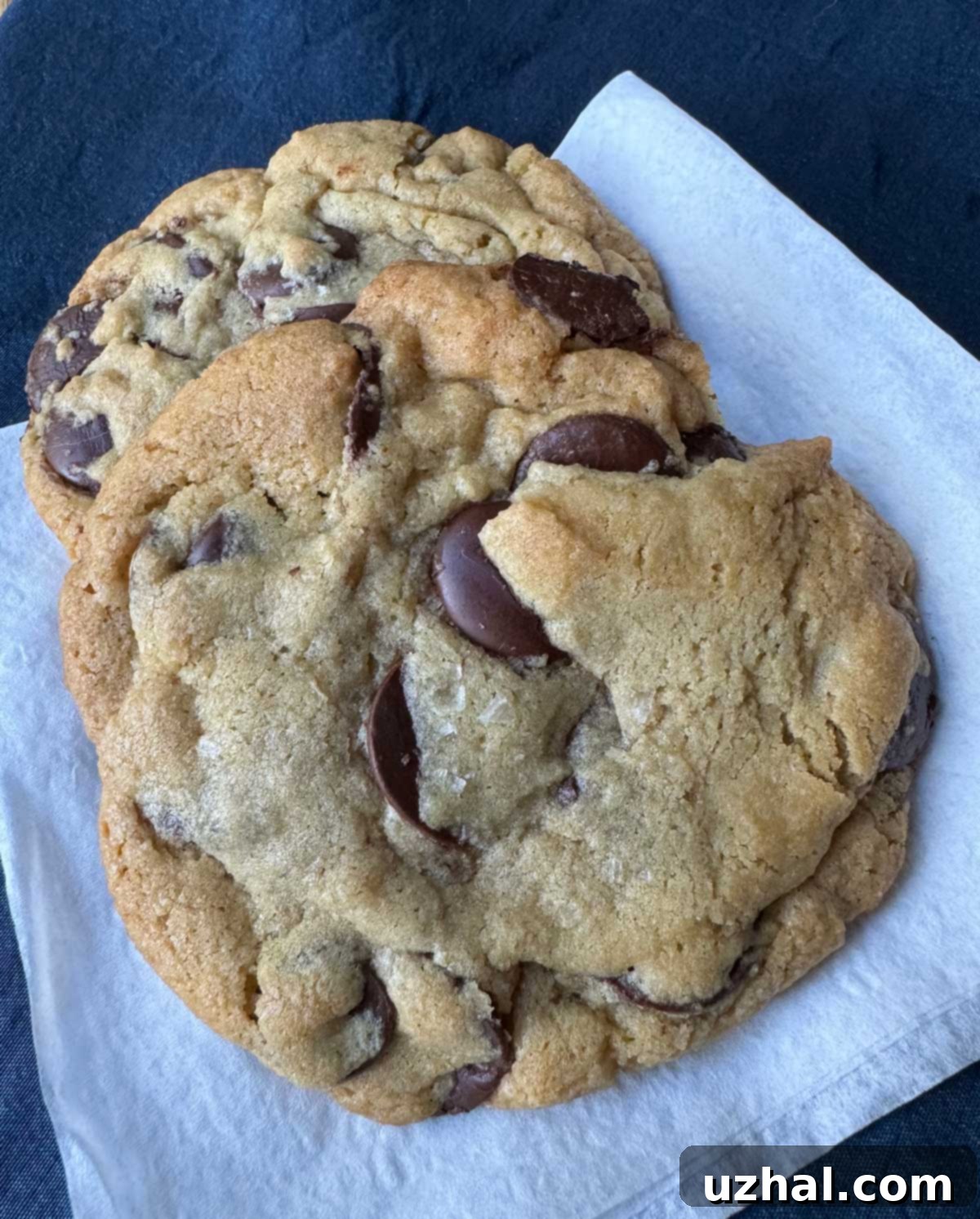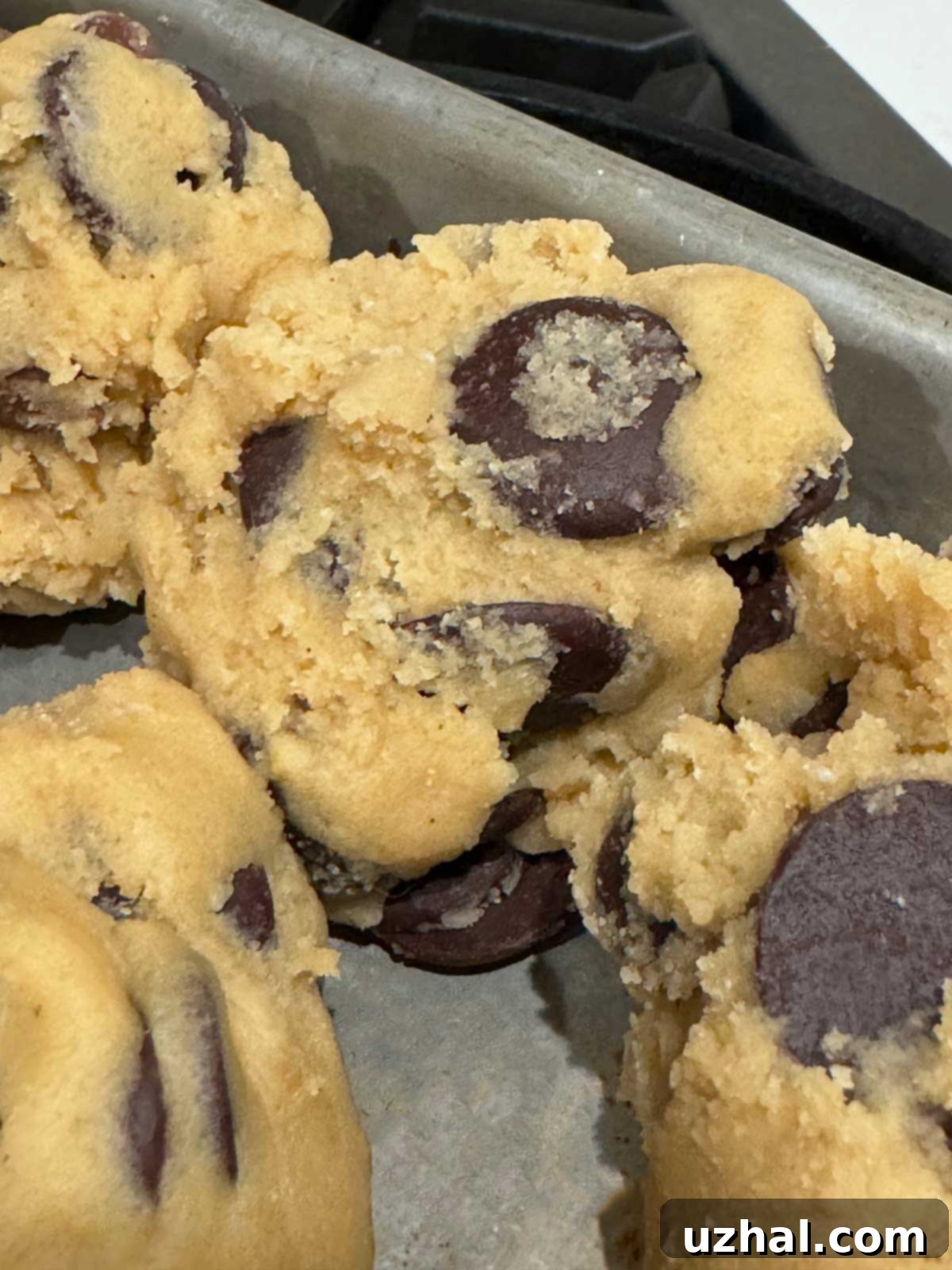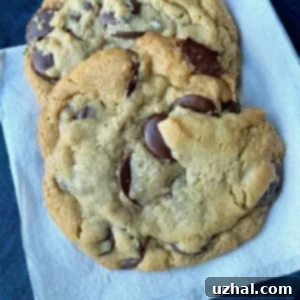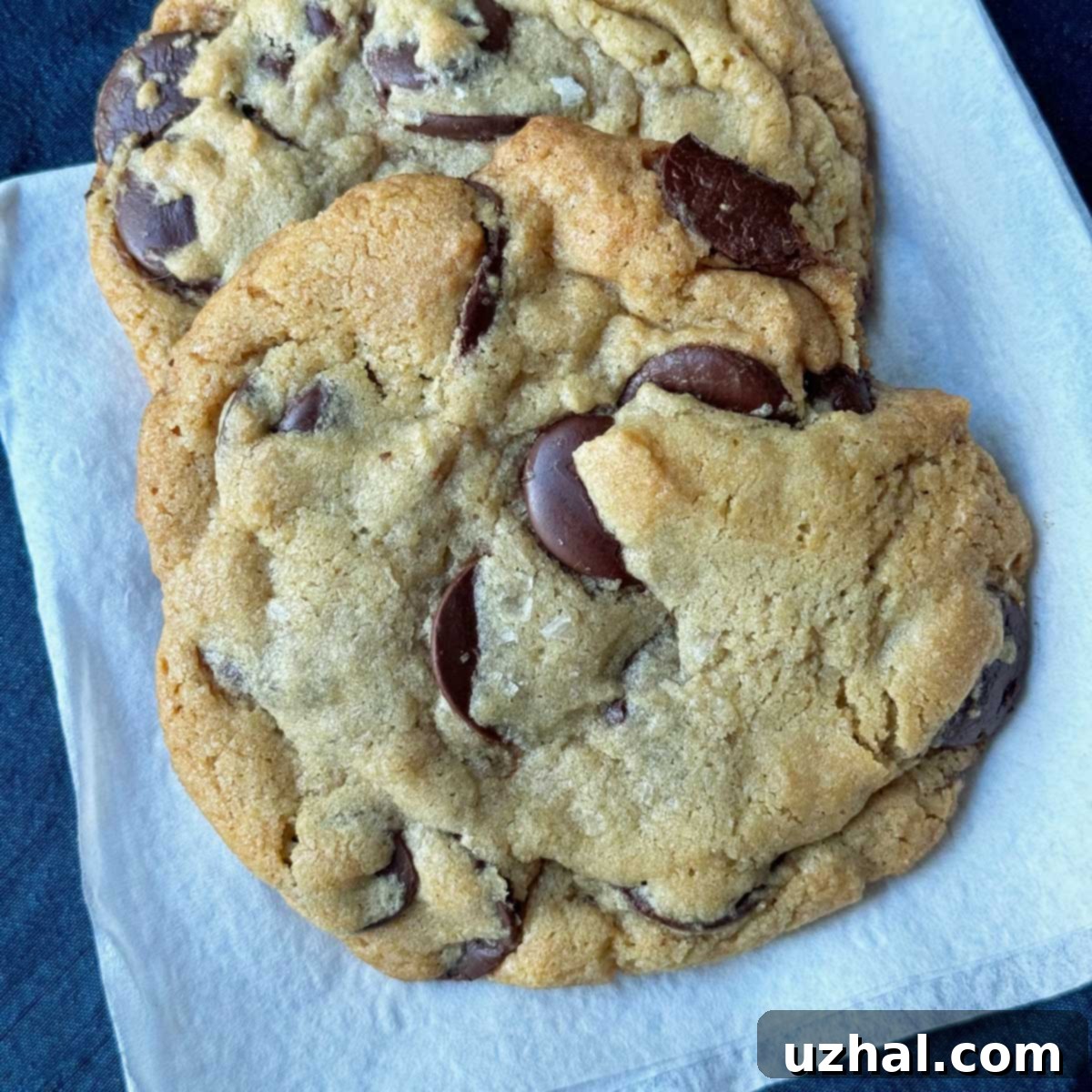Unlocking the Legendary Jacques Torres Secret Chocolate Chip Cookie Recipe: Your Ultimate Copycat Guide
The first time I experienced the marvel that is the Jacques Torres Secret Chocolate Chip Cookie was at his iconic shop in Brooklyn. It wasn’t just a cookie; it was an revelation. These were no ordinary treats – they were substantial, boasting a perfect medium thickness, and what truly set them apart was the mesmerizing stratification of chocolate throughout every bite. This unique layered effect is achieved not with standard chocolate chips, but with Chocolate Féves, those elegant, flat disks of high-quality chocolate typically reserved for melting and dipping. Torres ingeniously incorporates them into his cookie dough, allowing them to melt and spread, creating exquisite strata of rich chocolate that elevate the entire experience.
Since that initial encounter, these cookies have soared to culinary fame, inspiring numerous enthusiasts and home bakers to seek out the elusive “secret” recipe. Many copycat versions have emerged, prominently featuring recipes from esteemed publications like the New York Times and the culinary guru Martha Stewart. Both offer commendable takes on the original, yet after extensive experimentation and countless batches, I’ve managed to refine a third version. This iteration, I believe, captures an even more authentic essence of the original, with subtle adjustments that make it stand out from its widely circulated counterparts.
Jump to Recipe

Jacques Torres Cookie Legacy & Recipe Variations: Deciphering the Differences
The journey to replicate a beloved recipe often involves comparing different interpretations. When it comes to the Jacques Torres chocolate chip cookie, two of the most popular copycat recipes come from the New York Times (often credited to David Leite) and Martha Stewart. While both aim to capture the magic of the original, they present distinct approaches, leading to noticeable differences in the final product.
The Original Experience: What Makes Them Special?
The Jacques Torres cookies are celebrated for their distinctive texture and profound chocolate flavor. The combination of different flours, specific sugars, and crucially, the chocolate féves, contributes to a cookie that is both chewy and slightly crisp at the edges, with a soft, rich interior. The “secret” lies in these elements working in harmony, alongside specific techniques like chilling the dough, which allows the flavors to meld and the fats to solidify, resulting in a more complex and satisfying cookie.
Decoding the Copycats: NYT vs. Martha Stewart
Let’s delve into how the New York Times and Martha Stewart versions diverge. Martha Stewart’s recipe, for instance, typically calls for double the quantities of the acclaimed NYT version, and more significantly, features different ingredient ratios. This can drastically alter the texture and spread of the cookies. A common challenge with Martha’s recipe, however, is the omission of ingredient weights alongside volumetric measurements. Baking is a science, and the precision offered by weighing ingredients can make a monumental difference. Without this, results are prone to vary considerably from one kitchen to another, simply based on how individuals scoop and measure their flour – a notoriously inconsistent method.
Furthermore, different brands of pastry flour can have varying densities, further exacerbating the inconsistency when relying solely on volume. In my own experience, the Martha Stewart version tends to yield a cookie that is a little softer and more “cakey” than the chewier, richer NYT counterpart. The difference is subtle but distinct for those seeking the precise texture of the original.
An early attempt at Martha’s recipe, depicted in the vintage photograph below, highlights a crucial point: the absence of chocolate féves. Instead, I used large chunks of chocolate. While still delicious, the resulting cookies lacked the signature stratified layers of chocolate that define the Jacques Torres original, showcasing large, distinct pockets of chocolate rather than integrated layers.
The Magic of Chocolate Féves: Achieving Stratified Perfection
The true “secret” behind the Jacques Torres cookie’s distinctive appearance and mouthfeel largely rests on one key ingredient: Chocolate Féves. These small, flat, oval-shaped discs of high-quality chocolate are specifically designed for melting smoothly and evenly. When used in cookies, as Torres brilliantly does, they don’t hold their chip shape. Instead, they melt and spread beautifully within the dough, creating those coveted, luxurious layers of chocolate that run through the entire cookie, rather than isolated pockets of chips.
Beyond the visual appeal, the melted chocolate féves contribute significantly to the cookie’s unique texture. As they melt, they release cocoa butter and other fats into the surrounding dough. This infusion of fat helps create a richer, more tender crumb and prevents the cookie from becoming overly cakey. It imparts a delightful chewiness and a depth of flavor that traditional chocolate chips, which tend to hold their shape more, simply cannot replicate. The féves essentially lubricate the dough from within, enhancing its moistness and contributing to the overall decadent experience.
While the updated David Leite version in the NYT recipe is more forgiving and adaptable to various types of chocolate, for those aiming for the most authentic Jacques Torres experience, prioritizing chocolate quality is paramount. I often find myself reaching for Ghirardelli’s bittersweet chips when féves aren’t available, or a combination of good quality chocolate chunks I have on hand. However, for a truly comparable alternative to the original Valrhona Chocolate Féves, Guittard’s chocolate wafers come remarkably close. They offer a similar melt profile and rich flavor, allowing for that desired stratified effect. These are excellent choices for home bakers looking to replicate the signature chocolate layers without sourcing specific féves.

Introducing the “Real” Third Version: My Refined Jacques Torres Recipe
After years of baking, tasting, and tweaking, I’m thrilled to share what I believe is the most accurate and delightful copycat of the Jacques Torres Secret Chocolate Chip Cookie. This latest iteration (version #3!), I’ve been reliably informed, is a direct, scaled-down version of the actual recipe used in the Jacques Torres shops. It incorporates the nuanced ratios and specific techniques that yield a cookie truly reminiscent of the original masterpiece.
While the recipe works beautifully with any high-quality chocolate, for an experience that truly mirrors the shop’s offerings, I highly recommend using specialized chocolate féves. Their unique melting properties are, as discussed, key to achieving those coveted stratified layers of chocolate. However, if féves are not accessible, opting for large bittersweet chocolate chips or generously sized chocolate chunks will still produce an exceptional cookie with substantial chocolate presence. The key is to avoid regular-sized chocolate chips, as they tend to disperse too evenly and don’t provide the same impactful bursts of chocolate.
The size of the cookies themselves is also crucial. These are meant to be substantial, shareable (or not!) treats. I strongly advise keeping the cookies large. Each dough ball should weigh somewhere in the range of 3.5 to 3.8 ounces. This generous portion ensures a cookie that bakes up with a perfectly crisp edge and a deeply tender, chewy interior, allowing the complex flavors and textures to truly shine. The image above, while showcasing the baked cookie, gives a good indication of the impressive scale you’re aiming for with your dough balls, resulting in a truly satisfying, generously sized chocolate chip cookie.
- Ultimate Stand Mixer Chocolate Chunk Cookies
- New York Times Chocolate Chip Cookies
- Secret Ingredient Sugar Cookies
- Pineapple Extract Sugar Cookies
- Get Well Soon! Cookies
Recipe

Jacques Torres’ Secret Chocolate Chip Cookie Recipe
Anna
Pin Recipe
Ingredients
- 2 cups cake flour (230 grams, essential for tender texture)
- 1 ⅔ cups bread flour (230 grams, contributes to chewiness)
- 1 teaspoon baking soda (helps with spread and browning)
- 1 ⅓ teaspoon baking powder (just eyeball the ⅓ teaspoon, for lift and a soft center)
- 1 ½ teaspoons coarse salt (enhances flavor and balances sweetness)
- 18 ½ tablespoons unsalted butter (260 grams, at room temperature for best creaming)
- 1 ¼ cups light brown sugar, packed tightly (260 grams, for moisture and chew)
- 1 cup plus 2 tablespoons granulated sugar (220 grams, for crispness and sweetness)
- 2 large eggs (105 grams, at room temperature, for binding and moisture)
- 2 teaspoons vanilla extract (high quality for best flavor)
- 3 cups large bittersweet chocolate chips or Chocolate Feves (Valrhona or Guittard wafers recommended for optimal results)
- coarse salt or Maldon salt for sprinkling on top (enhances flavor and provides a gourmet touch)
Instructions
-
Important First Step: Do not preheat your oven yet because this cookie dough absolutely requires significant chilling time to develop flavor and achieve the perfect texture. Plan ahead for best results.
-
In a large mixing bowl, thoroughly whisk together both the cake flour and bread flour, baking soda, baking powder, and coarse salt. The combination of two flours is crucial for the unique chew and tender crumb. Set this dry ingredient mixture aside.
-
In the bowl of an electric mixer fitted with the paddle attachment, cream together the room-temperature unsalted butter and both types of sugar (light brown and granulated) on medium speed until the mixture is light, fluffy, and pale in color, typically 2-3 minutes. This aeration is key to cookie texture. Add the eggs one at a time, mixing well after each addition to fully incorporate. Reduce the mixer speed to low, add the vanilla extract, and mix just until blended, making sure to scrape down the sides and bottom of the bowl with a spatula to ensure everything is evenly combined.
-
Gradually add the prepared flour mixture to the wet ingredients. Mix on low speed until just blended and no dry streaks of flour remain. Be careful not to overmix, as this can develop the gluten too much and lead to tough cookies. Finally, add the large bittersweet chocolate chips or Chocolate Féves and mix just until they are evenly distributed throughout the dough.
-
Using a large cookie scoop or your hands, scoop generous mounds of dough. Each dough ball should weigh between 3.5 to 3.8 ounces for optimal results. Place these large dough balls on a parchment-lined tray or a couple of plates, ensuring they are not touching. Cover them tightly with plastic wrap to prevent drying and chill in the refrigerator overnight (for at least 12-24 hours). This chilling period is non-negotiable for flavor development and texture.
-
When you are ready to bake your delicious cookies, preheat your oven to 350°F (175°C). Line a baking sheet with parchment paper. Arrange the chilled dough balls on the prepared baking sheet, spacing them approximately 3 inches apart to allow for proper spread. For an extra touch of gourmet flavor and visual appeal, you can lightly sprinkle the tops of each dough ball with a pinch of coarse sea salt or Maldon salt before baking.
-
Bake in the preheated 350°F (175°C) oven for about 18-20 minutes, or until the edges are lightly golden brown but the centers still appear soft and slightly underbaked. This ensures a wonderfully chewy interior. Remove from the oven and let the cookies cool on the baking sheet for a few minutes before transferring them to a wire rack to cool completely. The residual heat will continue to cook them slightly.
Tips for Baking the Perfect Jacques Torres Copycat Cookies
Achieving Jacques Torres-level chocolate chip cookies at home is entirely possible with attention to detail. Here are some essential tips to ensure your batch turns out perfectly:
- Embrace the Chill: The overnight chilling of the dough is perhaps the most critical step. It allows the flours to fully hydrate, the sugars to dissolve, and the flavors to deepen and meld. More importantly, it solidifies the butter, which prevents the cookies from spreading too much in the oven, leading to thicker, chewier cookies with crinkled edges. Do not skip this step!
- Weigh Your Ingredients: As mentioned, accuracy is paramount in baking. Investing in a digital kitchen scale will drastically improve the consistency and quality of your baked goods. Flour, in particular, can vary significantly in weight depending on how it’s scooped.
- Quality Chocolate Matters: The type of chocolate you use directly impacts the cookie’s flavor and texture. If Valrhona or Guittard féves/wafers are out of reach, choose a high-quality bittersweet or semi-sweet chocolate with a cocoa content of 60-70%. Avoid cheap chocolate chips that often contain stabilizers and don’t melt as beautifully.
- Room Temperature Ingredients: Ensure your butter and eggs are at true room temperature. This allows them to cream together properly, creating a smooth, emulsified base that holds air, which is essential for a tender cookie.
- Don’t Overmix the Dough: Once you add the dry ingredients to the wet, mix only until just combined. Overmixing develops gluten, leading to tougher cookies. The same goes for adding the chocolate – mix only until just distributed.
- Proper Spacing on Baking Sheet: Give your large cookie dough balls plenty of space on the baking sheet (at least 3 inches apart). This prevents them from merging into one giant cookie and allows for even heat circulation, promoting proper browning.
- Watch for Doneness: The ideal Jacques Torres cookie is slightly underbaked in the center. Look for golden-brown edges, but a center that still looks soft and perhaps a little puffy. They will continue to set as they cool on the baking sheet.
- The Salt Sprinkle: Don’t underestimate the power of coarse sea salt or Maldon salt sprinkled on top before baking. It provides a delightful contrast to the sweet chocolate and enhances all the flavors.
- Storage: Once completely cooled, store your cookies in an airtight container at room temperature for up to 3-4 days. They’re best enjoyed fresh, but often taste even better the next day as the flavors continue to develop.
Conclusion: The Ultimate Homemade Indulgence
Recreating the Jacques Torres Secret Chocolate Chip Cookie is more than just following a recipe; it’s an experience in understanding the nuanced art of baking. By paying close attention to the details—from the specific blend of flours and sugars to the magic of chocolate féves and the crucial chilling period—you can produce a cookie that rivals the legendary original. This comprehensive copycat guide provides you with all the insights and steps needed to achieve those coveted layers of rich chocolate, the perfect balance of chewiness and crispness, and a flavor profile that is simply unforgettable. Get ready to impress your friends, family, and most importantly, yourself, with these truly extraordinary chocolate chip cookies.
